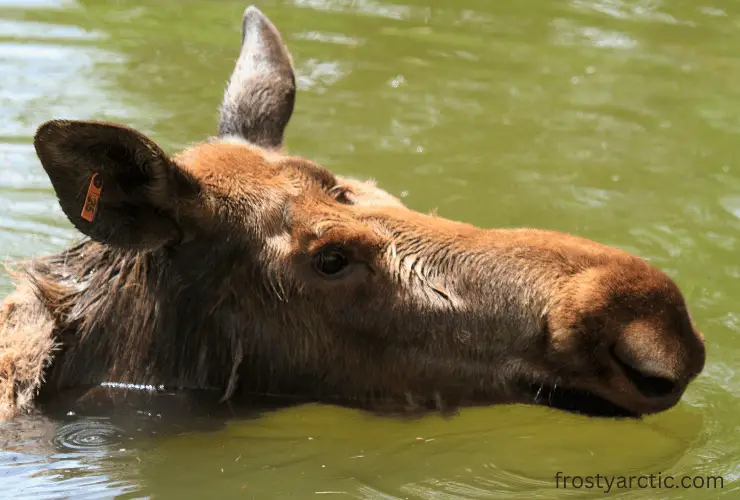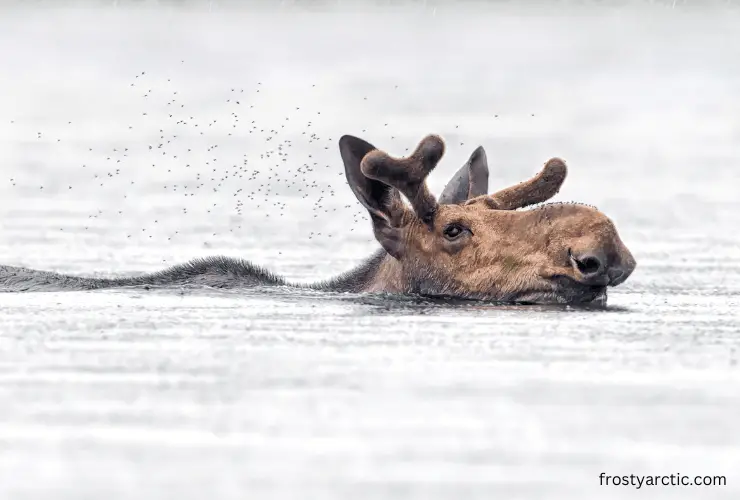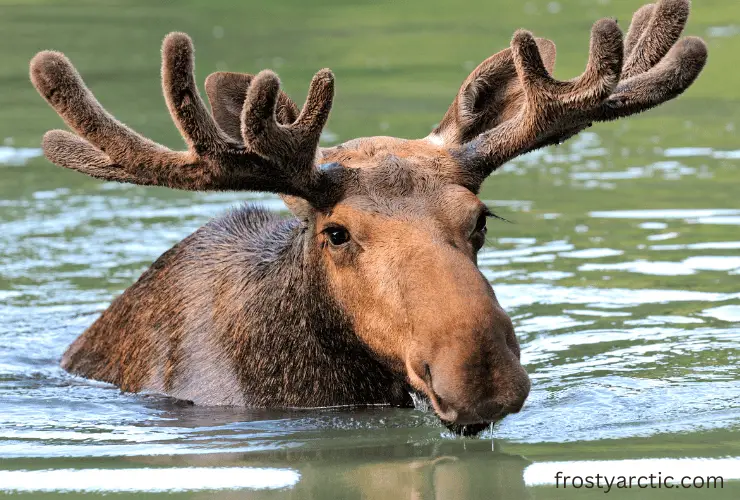Moose are adept divers and can hold their breath for approximately a minute. These massive animals are also known for their incredible swimming speeds, i.e., 6 miles per hour. Moose have large nostrils which close when moose enter the water, preventing water from entering the lungs.
Did you know that moose require at least 25 kilograms of aquatic plants daily?
Let’s learn more about moose and their behavior underwater, how long they can hold their breath, and how deep a moose can dive. So, let’s get started!
How Deep Can a Moose Dive?
Moose can dive 20 feet deep underwater. These animals spend most of their time gliding across ponds and other water bodies.
Thanks to their long legs, even a 4-foot pond is considered shallow for these massive animals. Moose can sink into deeper ponds because of their body weight.
Did you know? Moose can dive up to 20 feet or 6 meters underwater. They are the only member of the deer family that can chew and swallow underwater.
How Long Can a Moose Hold its Breath?
Research has shown that moose can hold their breath for nearly 50 seconds.
These animals can stay underwater for about 30 seconds, after which they come back up to the surface, fill their lungs with air, and dive down again.

Underwater moose forage for aquatic plants is more nutritious than on land. Their primary diet consists of various aquatic plants and animals, especially in the summer.
Moose’s bulbous noses allow them to eat and swallow food underwater, so they don’t have to return to the surface whenever they find something to eat.
However, in some cases, these animals have been observed to bring mouthfuls back to the surface, eat them, and then go back to the water to find more plants.
Can Moose Protect Themselves from Hypothermia When Diving In Cold Water?
Yes, moose can protect themselves from hypothermia when diving in cold water thanks to their thick winter coat, which acts as a life jacket, insulating them from the cold.
When the temperature decreases at the end of the summer season, moose start to shed their summer coat. Then, they start growing their winter coat, which is a multi-layered, thick coat.
Their winter coat consists of an outer layer with thick and long hairs. The inner layer is composed of guard hairs arranged in a honeycomb structure.
These hollow hairs create air pockets that keep the animal warm even when under the water.
Are Moose Safe from Predators Underwater?
Moose are comparatively better swimmers than their predators on land, which include grizzly bears, mountain lions, and wolves.
Mountain lions attack moose at the back of their neck, destroying the massive animal’s larynx and taking it down. Grizzly bears and humans are two of the biggest threats to moose on land.
So, if they detect the presence of any land predator around them, they will rush to seek shelter in the water. Underwater, their predators don’t stand a chance against moose.
Moose are such adept swimmers that they are known for traveling between islands for foraging. Research also suggests they can swim over ten miles without stopping.

But what about the predatory animals underwater that might threaten moose?
In the water, moose are often attacked by killer sharks and various types of whales known as Biggs killer whales.
Fun Fact: A comic strip created by Ben Hed shows moose being eaten by an orca whale. ~ Source
Did you know moose can run in deep water? Moose have long legs that make them adept swimmers. However, moose cannot run in deep water.
Adaptations of Moose That Help with Diving
Several biological adaptations enable moose to stay underwater, for example:
Fur:
Moose have hollow fur hair, which keeps them warm and helps them float in water, increasing the animal’s buoyancy. Air trapped inside the fur allows them to float on water.
Fur also functions as a life-jacket, insulating moose inside the water.
Did you know? When underwater, sharks are one of the biggest threats to moose. However, evidence suggests that sharks might choke on moose skin and fur because of their thickness. ~ TheWorld.org
Hooves and Strong Legs:
Moose are known for their long, slender legs and hooved feet, which help them run at fast speeds.
These features also allow it to swim for long distances and dive underwater in search of vegetation high in nutritional value. Their hooves act like paddles, allowing moose to swim at great speeds.
Valve-like Nostrils:
Moose are equipped with flexible, valve-like nostrils, which help them keep the water out when underwater. The nostrils close when the moose dives, preventing water from filling the lungs and suffocating the animal.
Bulbous Nose:
Moose don’t necessarily need to come to the surface after foraging aquatic plants in the sea. This is because of their bulbous nose, which allows them to chew and swallow underwater.
Conclusion
From their incredible fast running speed to their swimming talents, moose are incredibly fascinating creatures.
Looking at the massive and awkward body of the moose, it is hard to envision them diving underwater, but these animals are known for their diving and swimming abilities!
I hope this article cleared your doubts about how long a moose can hold its breath and dive underwater.



1 thought on “How Long Can a Moose Hold Its Breath?”